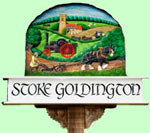Historically, the children of rural Stoke Goldington and Gayhurst received no formal schooling, but there had been some attempts to instruct at least a few.
18th Century
According to the Bucks Magna Britannia (*) in the early 18th Century there was a Charity School in Stoke Goldington, with 6 children taught “at the rector’s charge”
This didn’t stop the following criticism however:
Thomas Scott the Commentator, who was minister here, described Stoke Goldington village in 1773:-
“The country is pleasant, the village large and populous, but the people poor, ignorant and idle. The highest wage of the labourer in harvest time is only 1/6d per day, without meat.
Half of the inhabitants have little more knowledge, save the art of lace making, than they were born with.
There are no schools for the poor and they have no means of instruction but at church, where the greater part never come. Those that have any religion, are almost all Methodists, and fanatics of one sort or another.
Taking the whole country, I think it remarkably poor and ignorant”.
19th Century
Until the 1880s there was no Government Department responsible for Education in England. In 1833 the first Government Grant of £20,000 was made for the erection of school buildings and grants in aid of public subscription.
The grant was channelled into the country by 2 large rival organisations –
- The British and Foreign School Society.
- The National Society for Promoting the Poor in the Principles of the Established church
The attitude of the National Society was, on the whole, an uncompromising one during the period 1830 to 1850. Those who attended the National Schools were instructed in the liturgy and catechism of the Church of England.
The British School Society on the other hand was an un-denominational body, but the majority of its supporters were nonconformists. These opposed any claim that the Church should have control of the educational system – if we can call it that.
By 1837 this resulted in the formation of 2 new schools in Stoke read more…
20th Century
Little Abbey Boys Prep School 1946-1949
This prep school took boys from 5 to 14 and was briefly located at Gayhurst House after the war.
It would appear that Little Abbey School was formed in 1940 at Great Missenden, Bucks when two schools were evacuated, one school was from Hurst Green in East Sussex and the other was Shortenills Prep School (started in 1929) from Chalfont St Giles, Bucks.
Headmasters were:-
1)Major M G Hogg;
2) N H Granville Sharp with a deputy head, Mr Barnes.
In 1949 the school moved, from Gayhurst to Burghclere by Newbury.
Rodbourne College 1963 – 1969
After the war Gayhurst House became the home to Rodbourne Boys College, which moved from Warleigh nr. Bath in 1963. The Headmaster was Revd G W N Martin
(*) ‘Buckinghamshire Magna Britannica’. Page 16 (compiled by Cox 1720-35) Bucks County Library facsimile – L000.1
